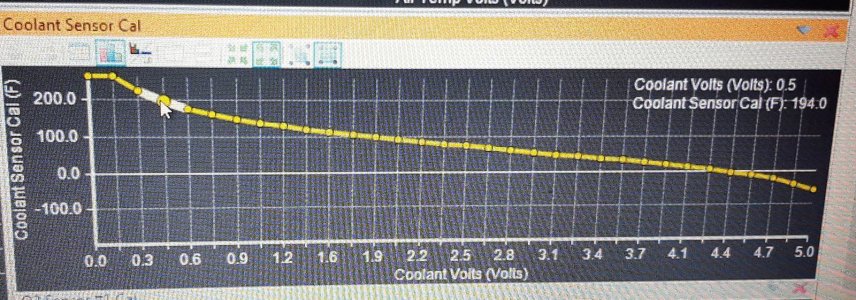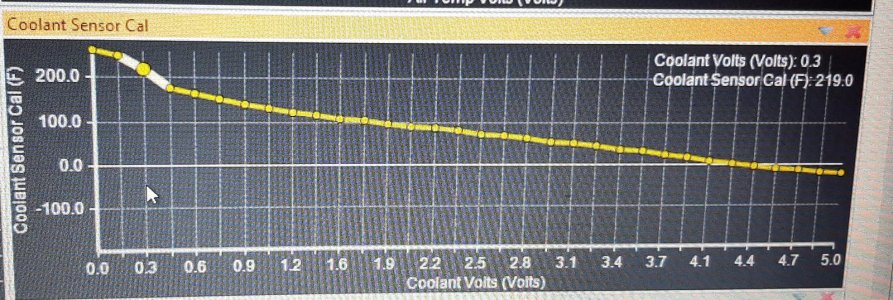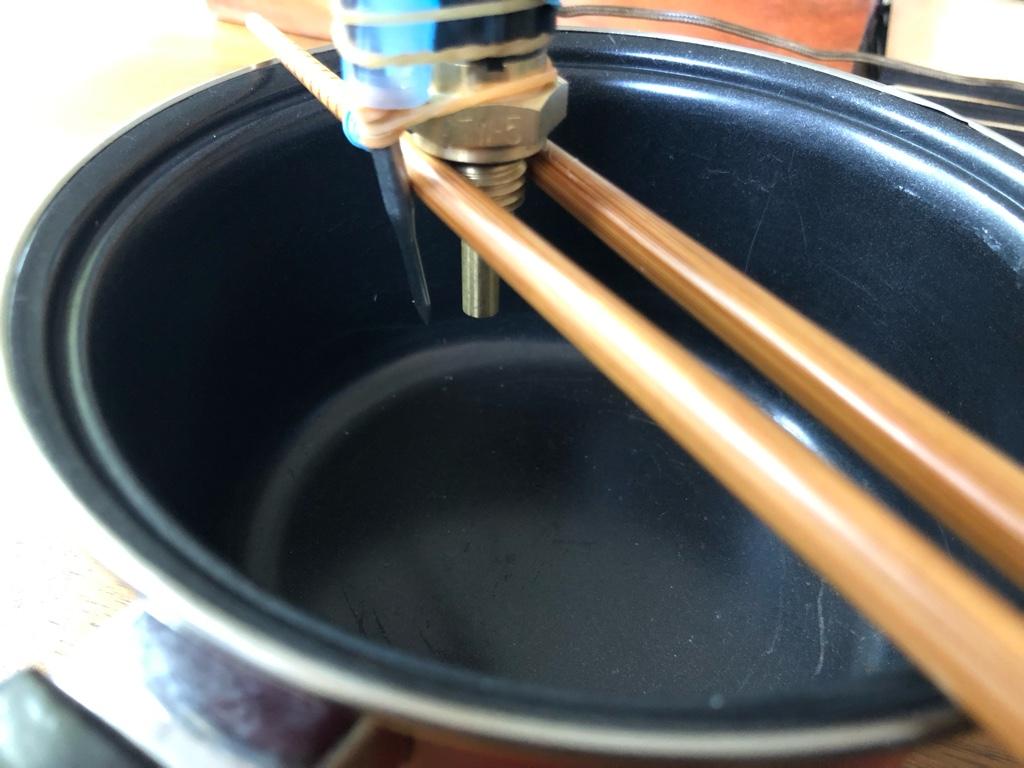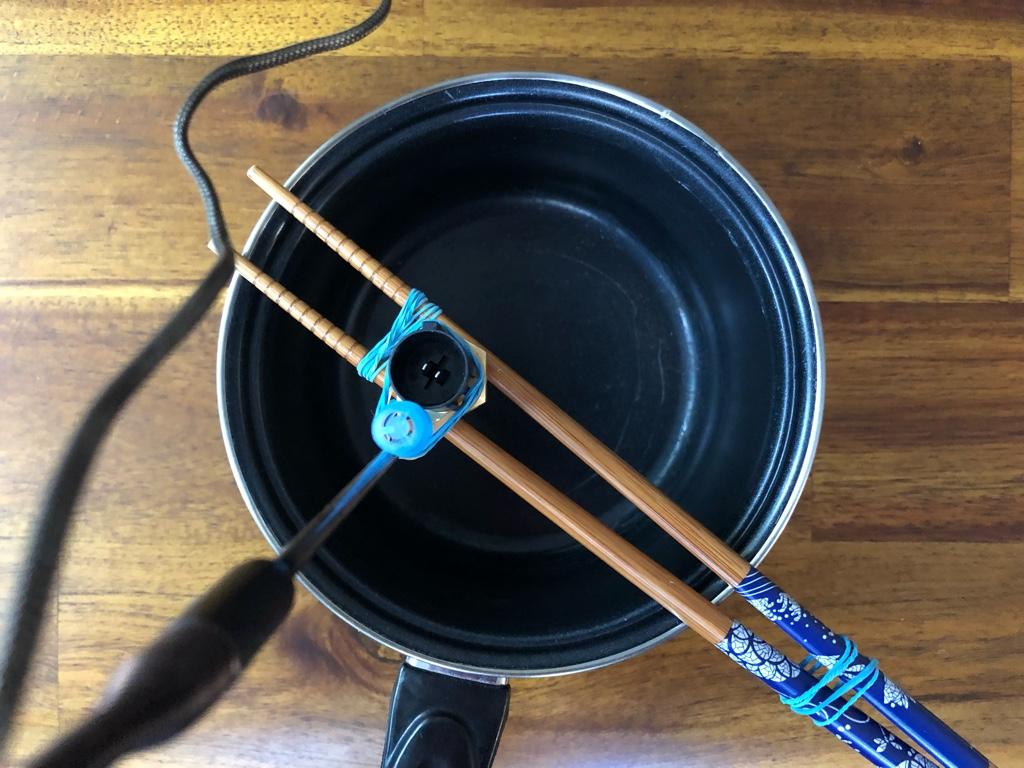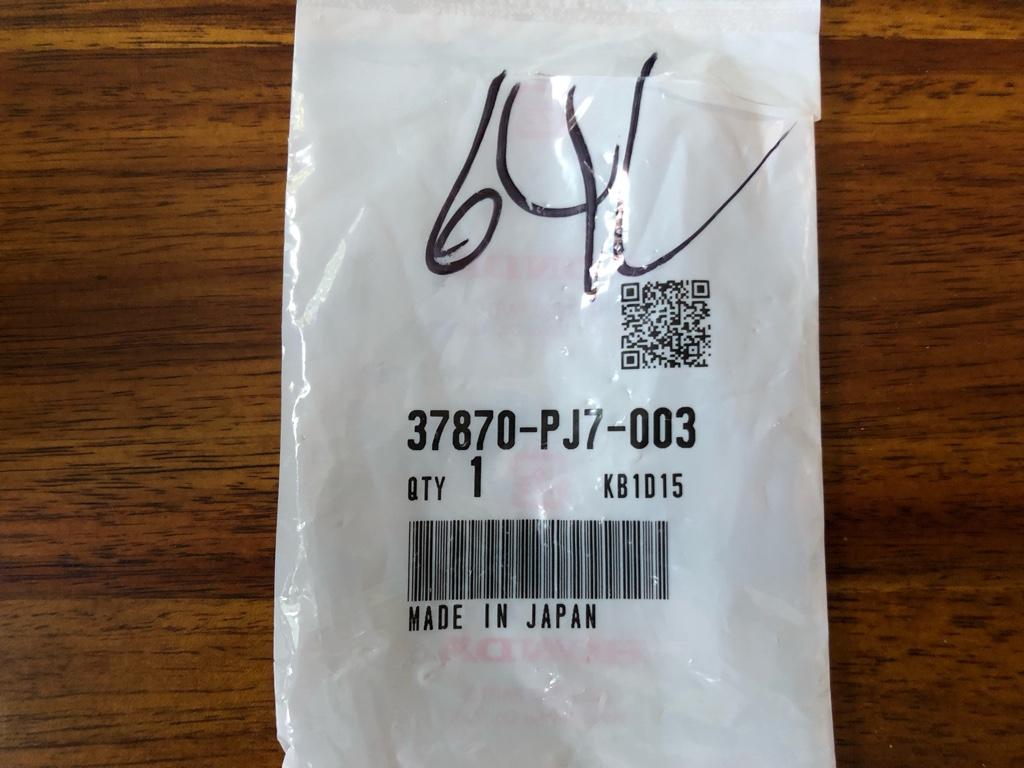Here's some tables. All are with 2.2k pullup resistor.
The NSX ECT sensor from infinity tuner:
Ohms table
ohms: F
250000: -9
21267: -4
9533: 14
6600: 25
4840: 36
3667: 46
2829: 57
2200: 68
1711: 79
1320: 90
1000: 104
733: 122
508: 149
314: 181
147: 226
0: 263
Voltage table
V: F
0: 263
0.16: 244.1
0.31: 226.37
0.47: 203.33
0.62: 181.65
0.78: 165.13
0.94: 148.82
1.09: 135.83
1.25: 121.98
1.4: 113.35
1.56: 104.14
1.72: 96.94
1.87: 90.22
2.03: 84.54
2.18: 79.26
2.34: 73.63
2.5: 68
2.65: 62.72
2.81: 57.09
2.96: 51.81
3.12: 46.18
3.28: 41.04
3.43: 36.24
3.59: 30.63
3.74: 25.35
3.9: 19.72
4.06: 14.09
4.21: 8.34
4.37: 2.19
4.52: -3.57
4.68: -5.75
4.84: -7.63
4.99: -9
Here's @Old Guy's ohms table above mapped onto the AEM volts scale. Looks like it might read a little low at operating temp? Edit: it jives more with the s2k one posted above than the infinity scale above.....
V: F
0: 263
0.16: 253.28
0.31: 227.26
0.47: 190
0.62: 167.71
0.78: 153.22
0.94: 139.2
1.09: 130.72
1.25: 121.67
1.4: 113.19
1.56: 104.14
1.72: 99.05
1.87: 94.34
2.03: 89.31
2.18: 84.6
2.34: 79.57
2.5: 74.55
2.65: 69.83
2.81: 64.15
2.96: 58.47
3.12: 52.4
3.28: 46.34
3.43: 40.66
3.59: 34.6
3.74: 27.57
3.9: 18.88
4.06: 10.18
4.21: 2.03
4.37: -4
4.52: -4
4.68: -4
4.84: -4
4.99: -4
EDIT2: And here is what came in my car (AEM series 1). Seems mine is even lower for a given voltage reading than Old Guy's. For a while I had an AEM coolant temp gauge sensor at the radiator as well, and they would basically agree. The car hovers around 0.47v (176) except on the hottest days, where it reads a little higher. I never changed it to the infinity settings as so many things in the ECU are dependent on ECT reading, I didnt want to rock the boat.
V: F
0: 223
0.16: 207
0.31: 190
0.47: 176
0.62: 163
0.78: 151
0.94: 142
1.09: 131
1.25: 122
1.4: 113
1.56: 104
1.72: 97
1.87: 90
2.03: 82
2.18: 77
2.34: 72
2.5: 66
2.65: 61
2.81: 55
2.96: 50
3.12: 45
3.28: 39
3.43: 34
3.59: 28
3.74: 21
3.9: 16
4.06: 10
4.21: 5
4.37: 0
4.52: -4
4.68: -8
4.84: -9
4.99: -11
The NSX ECT sensor from infinity tuner:
Ohms table
ohms: F
250000: -9
21267: -4
9533: 14
6600: 25
4840: 36
3667: 46
2829: 57
2200: 68
1711: 79
1320: 90
1000: 104
733: 122
508: 149
314: 181
147: 226
0: 263
Voltage table
V: F
0: 263
0.16: 244.1
0.31: 226.37
0.47: 203.33
0.62: 181.65
0.78: 165.13
0.94: 148.82
1.09: 135.83
1.25: 121.98
1.4: 113.35
1.56: 104.14
1.72: 96.94
1.87: 90.22
2.03: 84.54
2.18: 79.26
2.34: 73.63
2.5: 68
2.65: 62.72
2.81: 57.09
2.96: 51.81
3.12: 46.18
3.28: 41.04
3.43: 36.24
3.59: 30.63
3.74: 25.35
3.9: 19.72
4.06: 14.09
4.21: 8.34
4.37: 2.19
4.52: -3.57
4.68: -5.75
4.84: -7.63
4.99: -9
Here's @Old Guy's ohms table above mapped onto the AEM volts scale. Looks like it might read a little low at operating temp? Edit: it jives more with the s2k one posted above than the infinity scale above.....
V: F
0: 263
0.16: 253.28
0.31: 227.26
0.47: 190
0.62: 167.71
0.78: 153.22
0.94: 139.2
1.09: 130.72
1.25: 121.67
1.4: 113.19
1.56: 104.14
1.72: 99.05
1.87: 94.34
2.03: 89.31
2.18: 84.6
2.34: 79.57
2.5: 74.55
2.65: 69.83
2.81: 64.15
2.96: 58.47
3.12: 52.4
3.28: 46.34
3.43: 40.66
3.59: 34.6
3.74: 27.57
3.9: 18.88
4.06: 10.18
4.21: 2.03
4.37: -4
4.52: -4
4.68: -4
4.84: -4
4.99: -4
EDIT2: And here is what came in my car (AEM series 1). Seems mine is even lower for a given voltage reading than Old Guy's. For a while I had an AEM coolant temp gauge sensor at the radiator as well, and they would basically agree. The car hovers around 0.47v (176) except on the hottest days, where it reads a little higher. I never changed it to the infinity settings as so many things in the ECU are dependent on ECT reading, I didnt want to rock the boat.
V: F
0: 223
0.16: 207
0.31: 190
0.47: 176
0.62: 163
0.78: 151
0.94: 142
1.09: 131
1.25: 122
1.4: 113
1.56: 104
1.72: 97
1.87: 90
2.03: 82
2.18: 77
2.34: 72
2.5: 66
2.65: 61
2.81: 55
2.96: 50
3.12: 45
3.28: 39
3.43: 34
3.59: 28
3.74: 21
3.9: 16
4.06: 10
4.21: 5
4.37: 0
4.52: -4
4.68: -8
4.84: -9
4.99: -11
Last edited:



